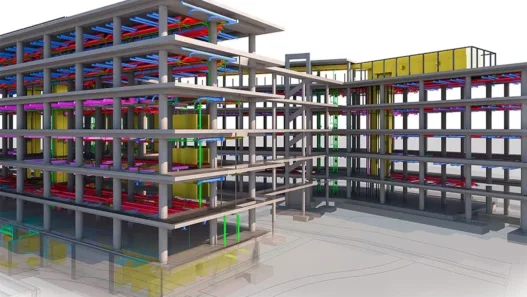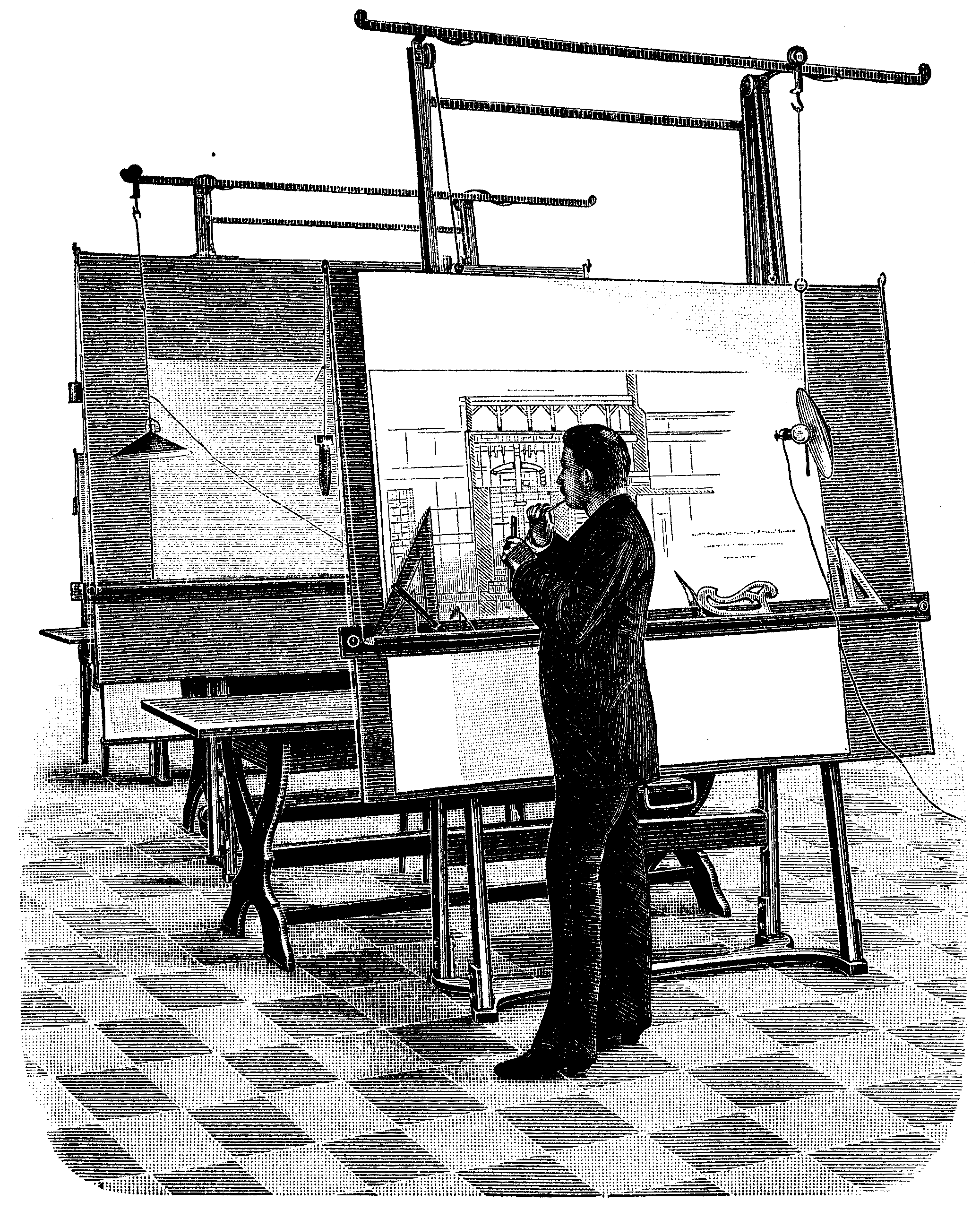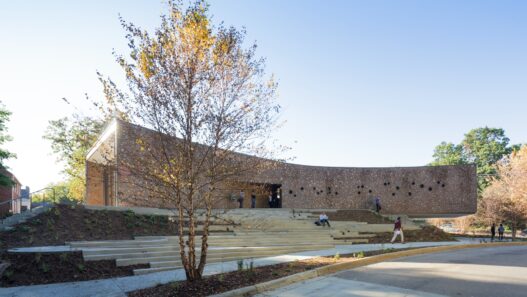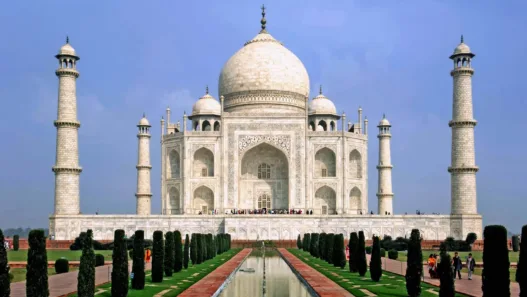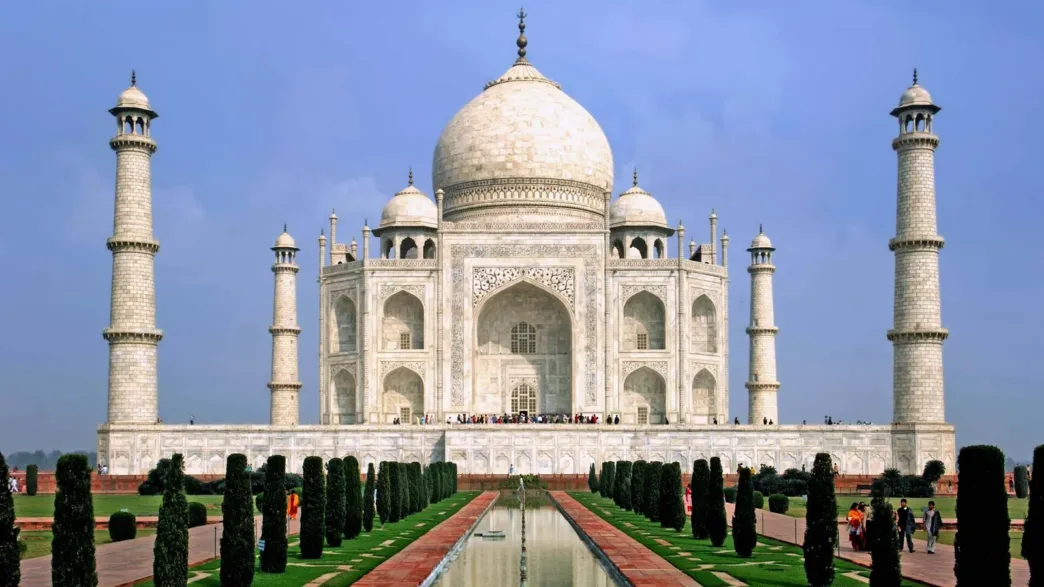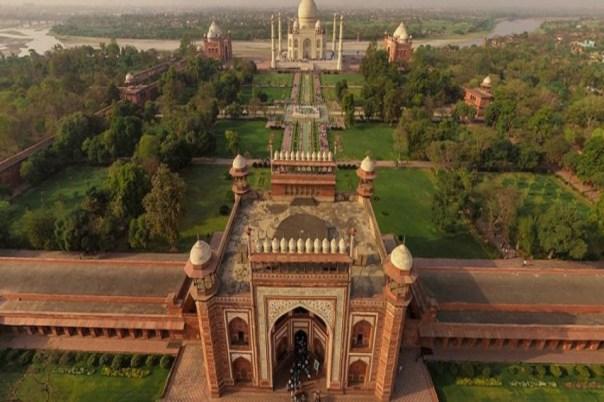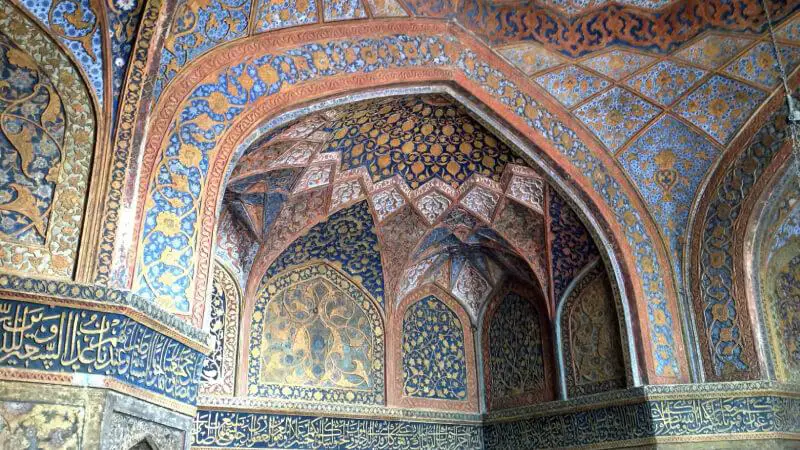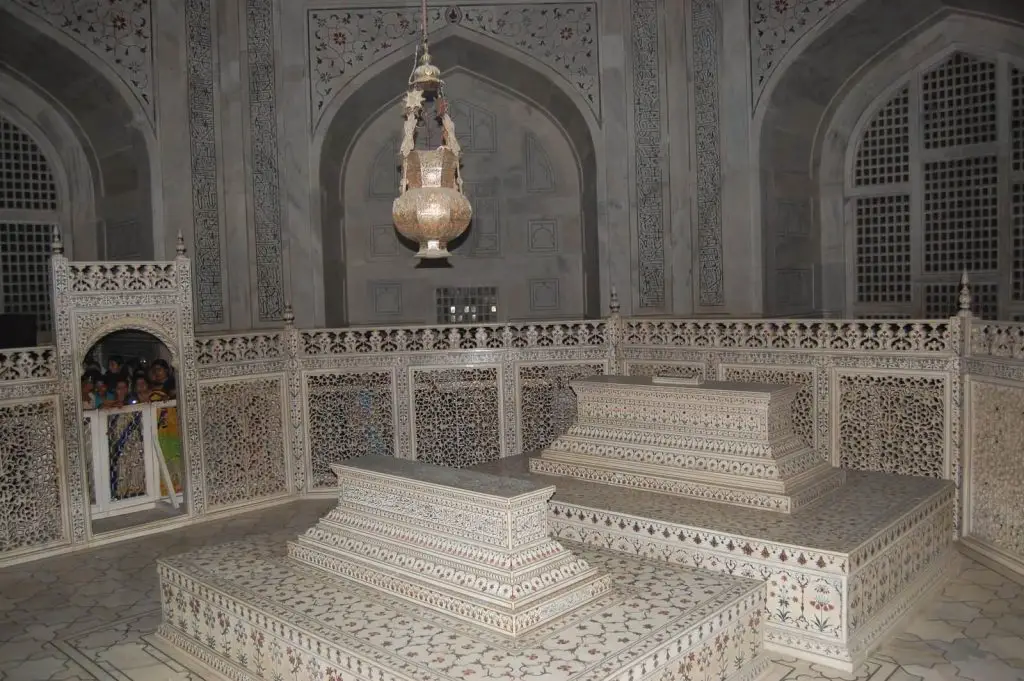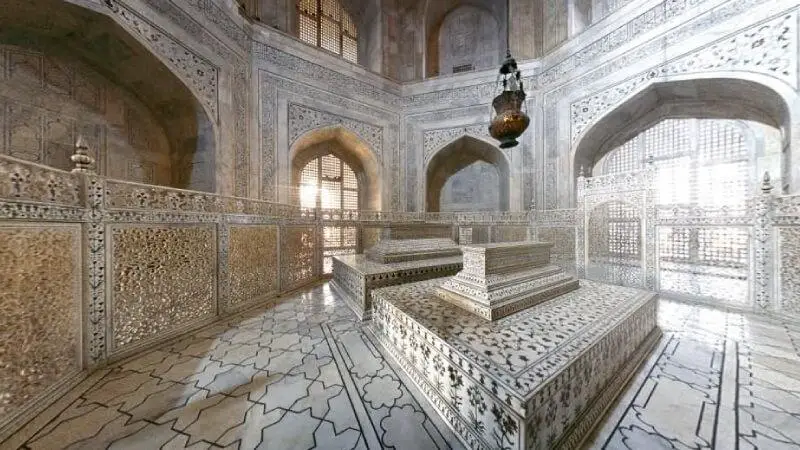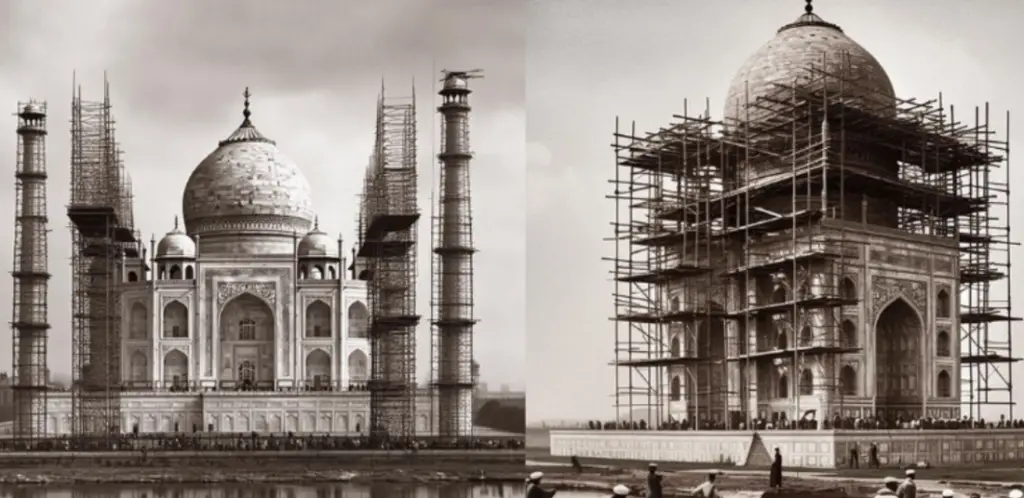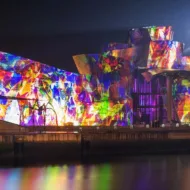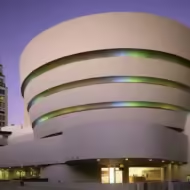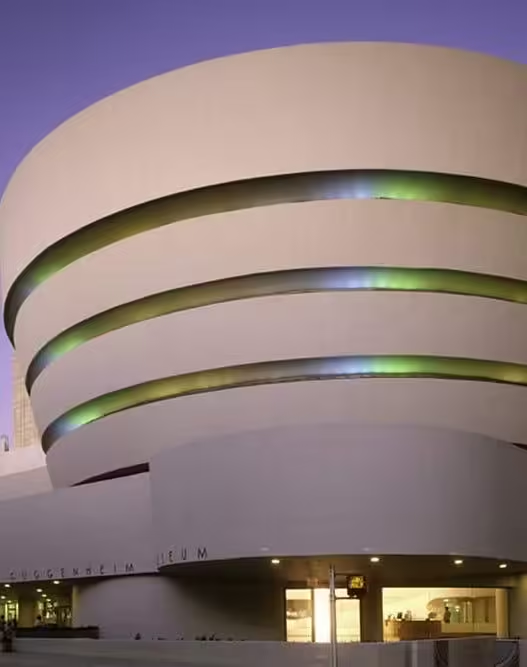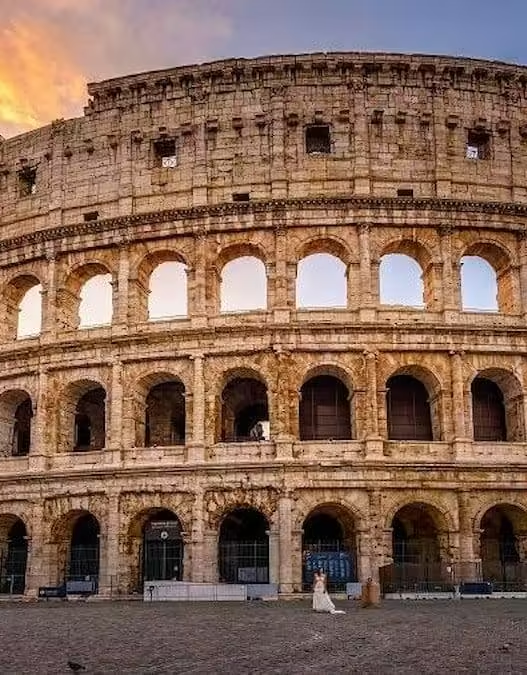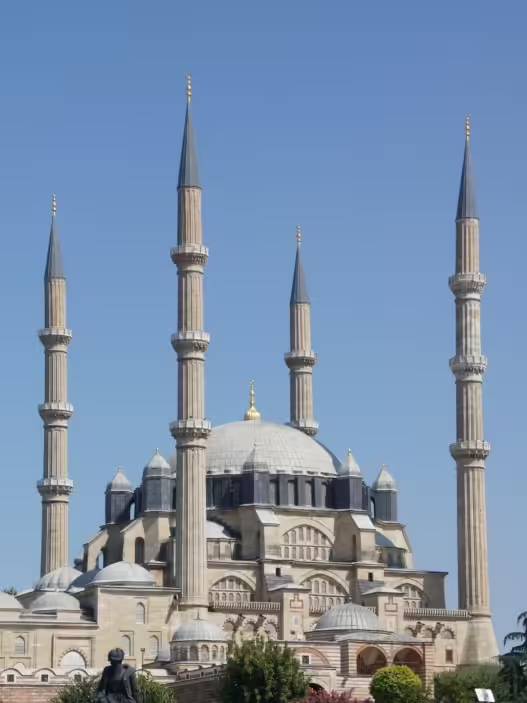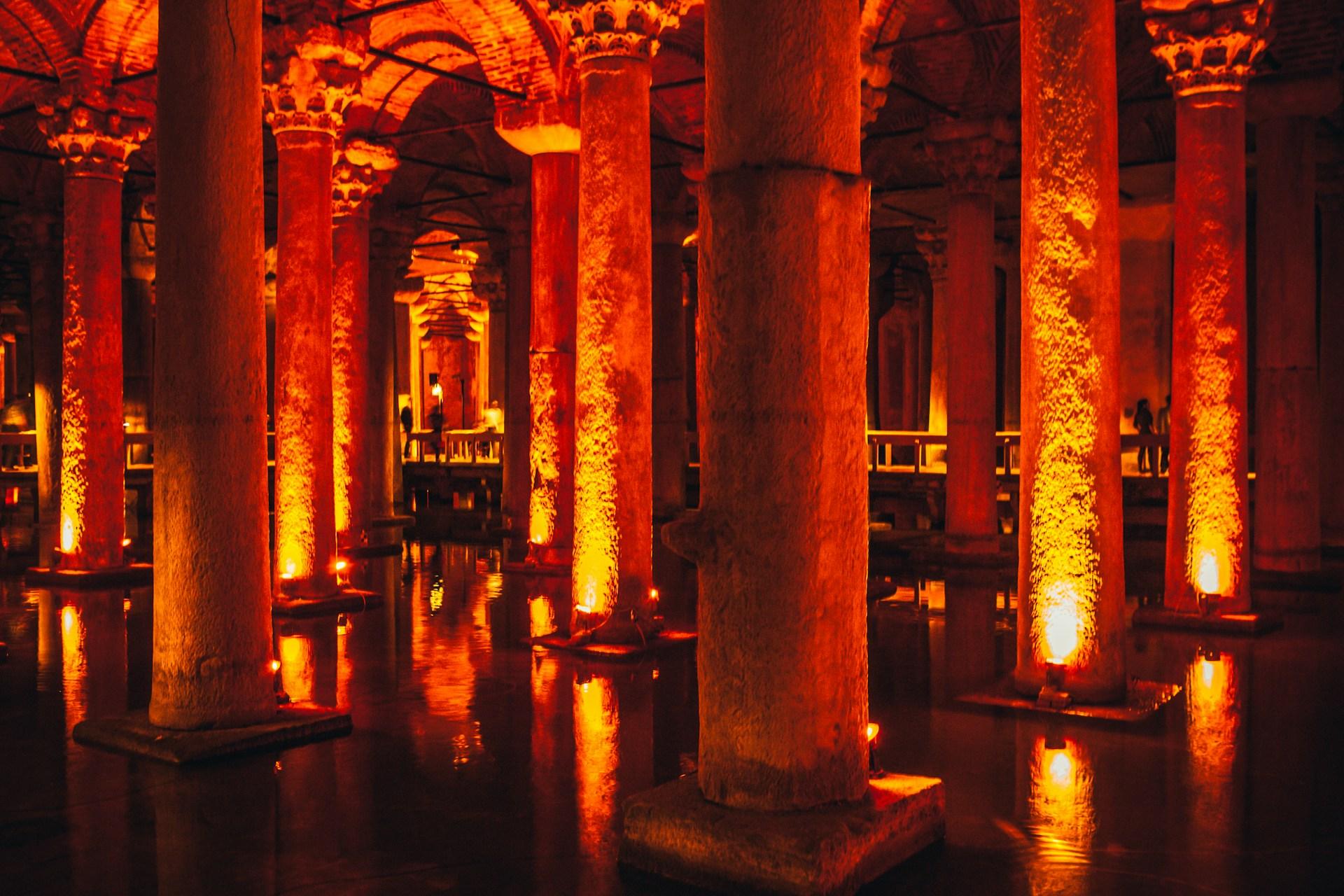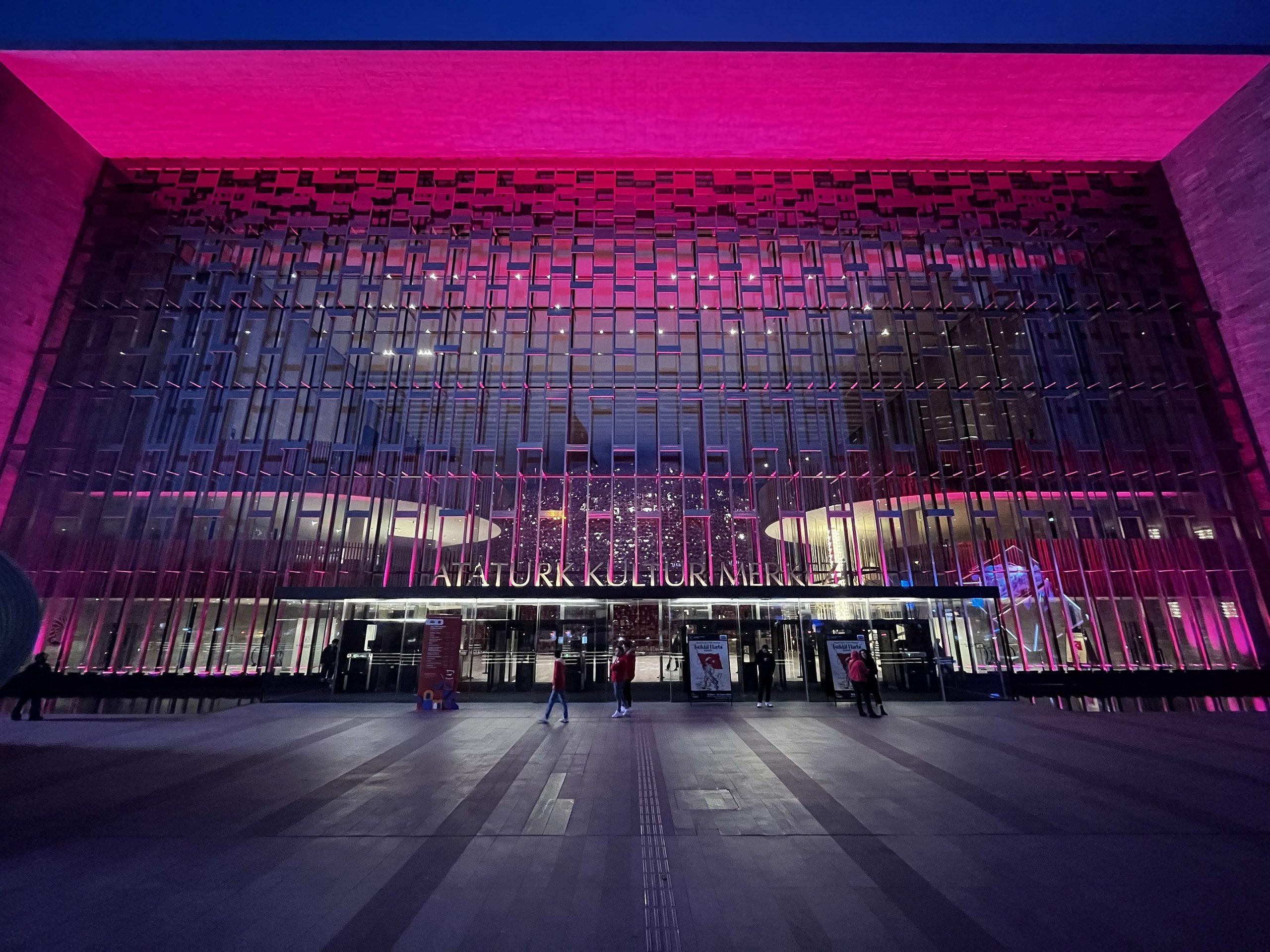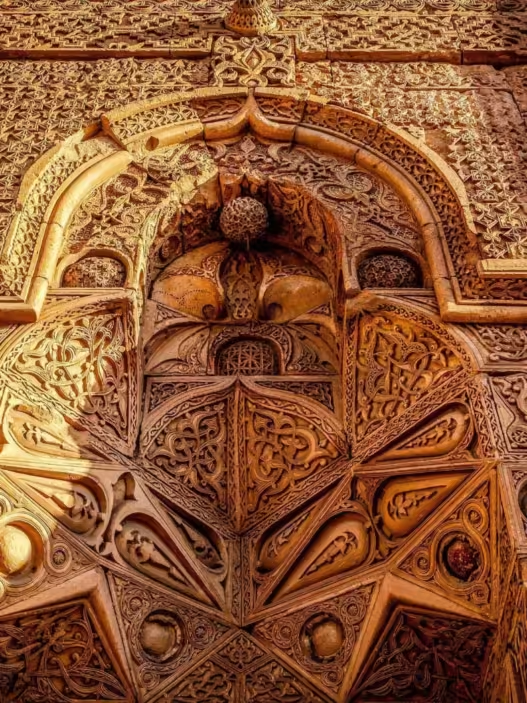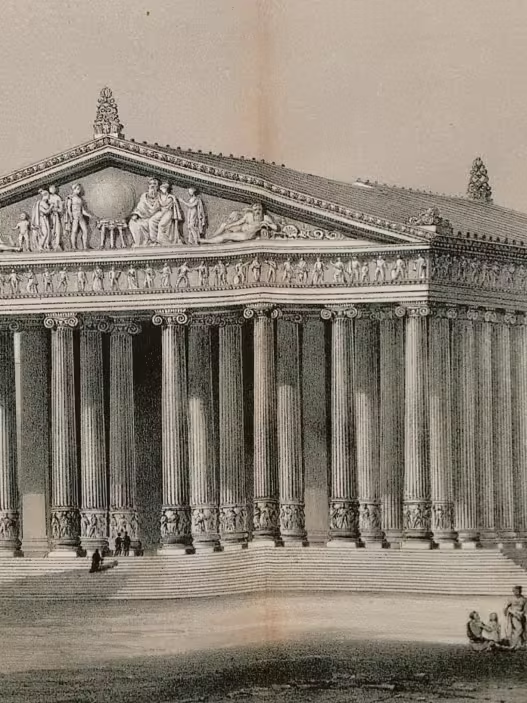The Taj Mahal is a world-famous architectural monument located in Agra, India. This magnificent structure was built by the Mughal Emperor Shah Jahan in memory of his beloved wife Mumtaz Mahal. Today, the Taj Mahal is recognized as a world heritage site and has become one of India’s most recognizable symbols.
- The Taj Mahal is a monumental architectural monument in Agra, India, built by the Mughal Emperor Shah Jahan in memory of his wife Mumtaz Mahal.
- The construction of the building began in 1632 and was completed in 1653. It was the result of the dedicated work of thousands of workers and craftsmen during the construction process.
- The Taj Mahal is considered the purest and most sublime expression of love and devotion. Shah Jahan’s deep love for Mumtaz Mahal has been perpetuated forever through this structure.
- The architects seamlessly combined the influences of Mughal, Islamic and Indian architecture to create the unique design of the Taj Mahal.
- The architecture of the building is mesmerizing with its exquisite details, symmetrical structures and majestic dome made of white marble.
- The interiors of the Taj Mahal include the mausoleum, which houses the tombs of Mumtaz Mahal and Shah Jahan. The burial chamber is elaborately decorated and offers an emotional atmosphere.
- Often used in Bollywood movies, the Taj Mahal stands out as a symbol of romance and sensuality.
- The Taj Mahal offers visitors an unforgettable experience and is one of India’s most well-known tourist attractions.
- Surrounded by legends and facts, the Taj Mahal adds to the mystery and charm of the structure.
- The Taj Mahal has a rightful place on the world heritage list as a symbol of architectural excellence and represents the creative abilities of humanity and the universal power of love.
Let’s take a detailed look at the architectural design, history and significance of the Taj Mahal.
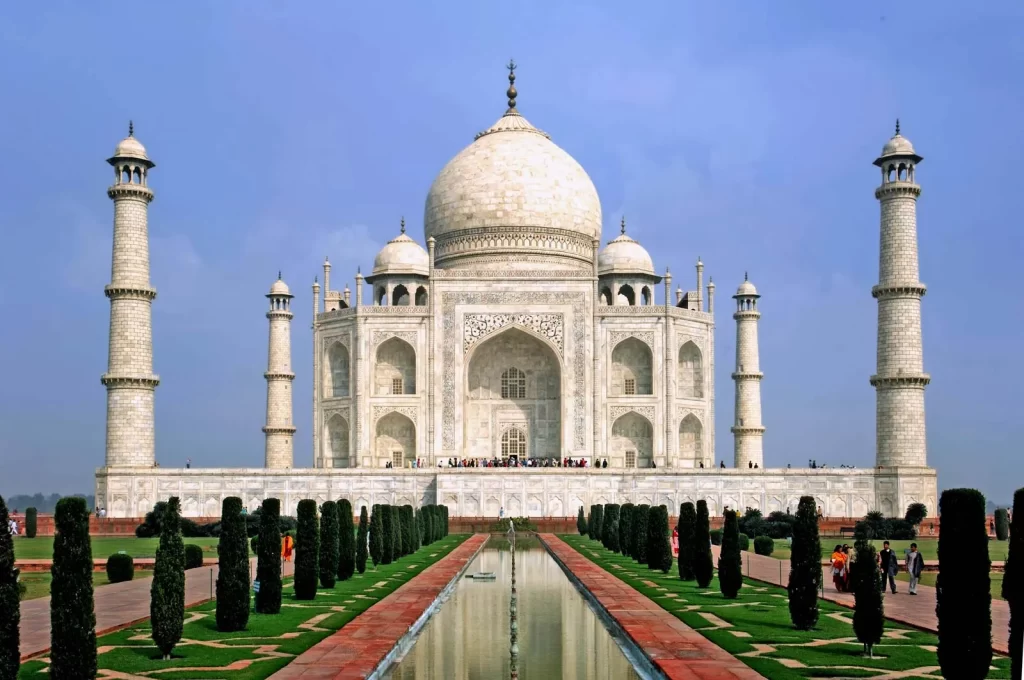
History and Architecture of Taj Mahal
Building Construction
Recognized as one of the most valuable treasures of the World Collective Cultural Heritage, the Taj Mahal is a historical monument since its construction began in 1632. Rising in Agra, India, this magical monument is recognized as a unique masterpiece that conveys the peak of the architectural and artistic talents of the Mughal Empire.
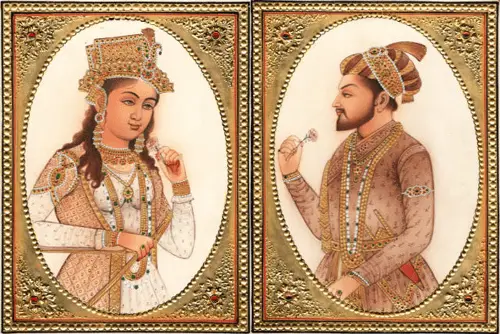
This work is based on the deep pain in the heart of the Mughal Emperor Shah Jahan after the sudden loss of his wife Mumtaz Mahal in 1631. Mumtaz Mahal was not only a wife to Shah Jahan, but also his closest friend and trusted advisor. She was Shah Jahan’s third wife and also his favorite wife. Mumtaz Mahal bore Shah Jahan 14 children and her loss moved the emperor not only emotionally, but also with an aesthetic and historical vision. His desire to perpetuate her memory and his undying love for her inspired the laying of the foundations of the Taj Mahal.
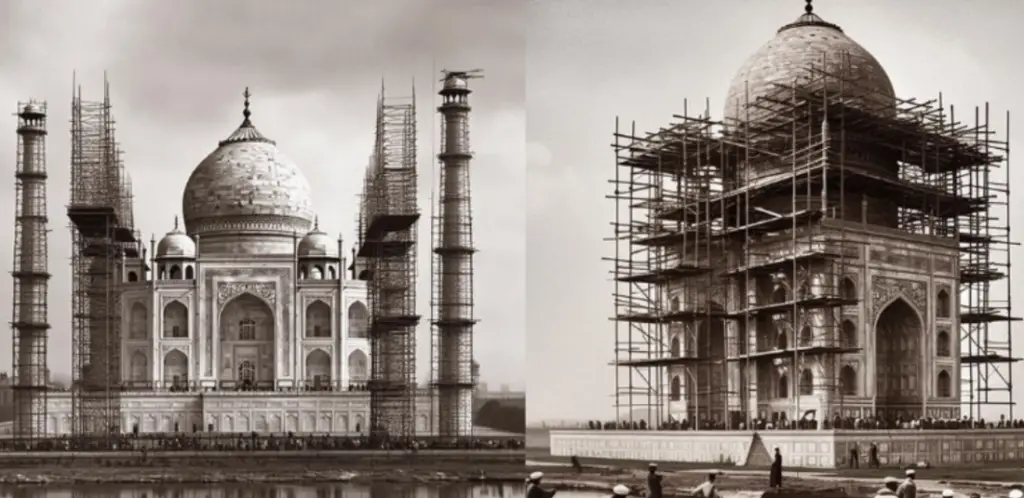
After nearly 20 years of meticulous construction, the Taj Mahal was finally completed and opened its doors to the world in 1653. Throughout this process, thousands of workers, under the guidance of master craftsmen, worked with great dedication to create this mesmerizing structure rising out of white marble.
Meaning and Symbolism
The Taj Mahal is considered the purest and sublime expression of love and devotion. Shah Jahan’s deep love for his wife Mumtaz Mahal has been perpetuated forever through this majestic monument. The structure is made of white marble, representing purity and innocence, while the intricacy of the intricate detailing reflects the depth of love.
Each minaret of the Taj Mahal is a symbol of the grandeur and power of the Mughal Empire at the time. The four minarets are a reflection of architectural perfection, adding balance and aesthetic integrity to the structure.
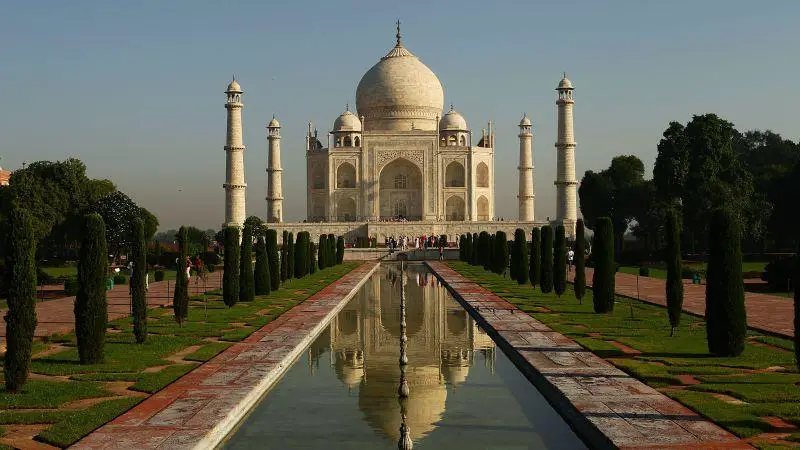
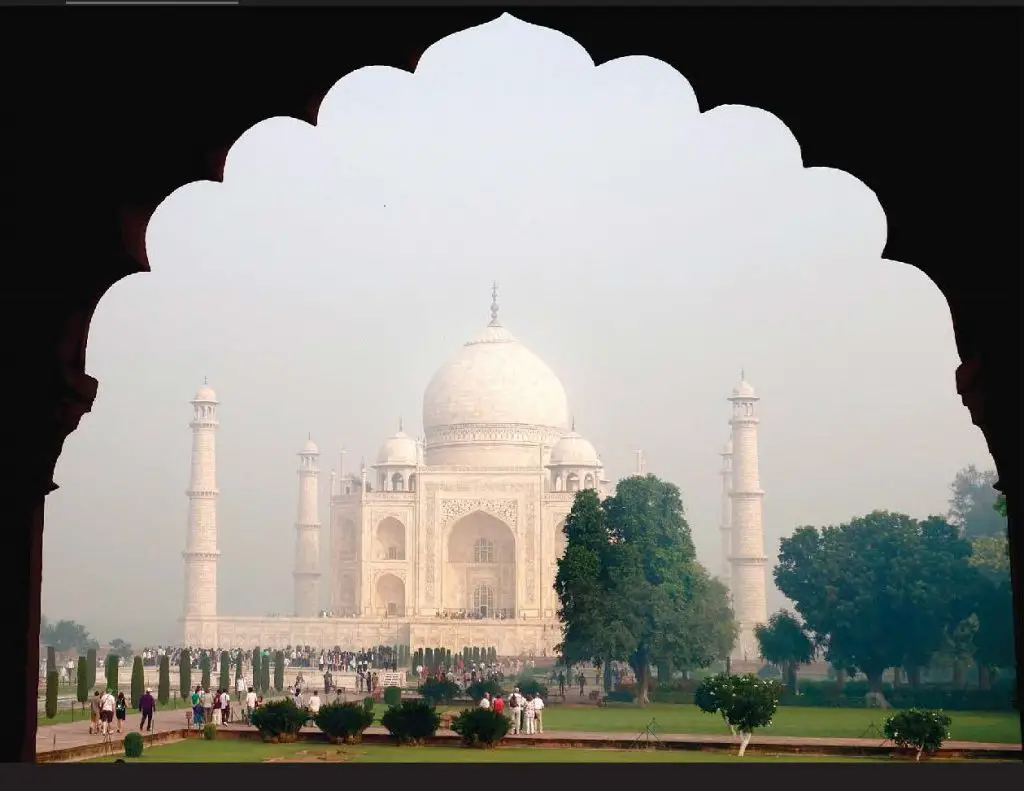
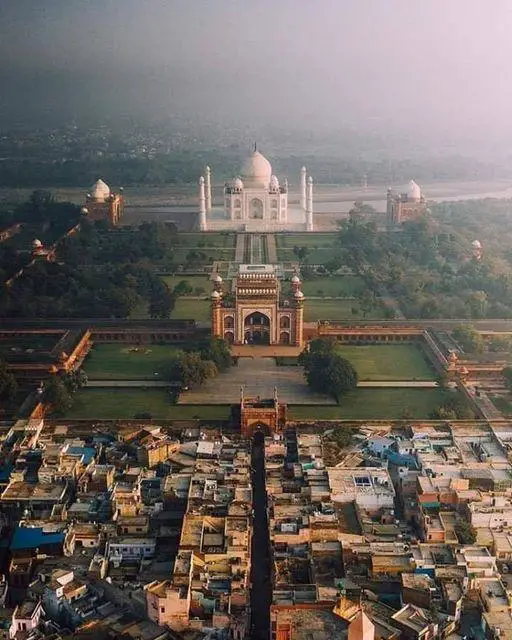

Today, the Taj Mahal is one of the most recognized and visited tourist attractions not only in India but in the whole world. The beauty of this magical structure continues to represent the universal power of love and the creative abilities of humanity. As the embodiment of a fairy tale from the past to the present, the Taj Mahal continues to provide an experience that impresses and captivates visitors.
The Role of Architects
Many talented architects and craftsmen were actively involved in the construction of the Taj Mahal. Chief Architect Ustad Ahmad Lahauri and other architects worked together to create this monumental structure. Other important architects such as Ustad Isa, Ustad Muhammad Hanif, Ustad Abdul-Karim Ma’mur Khan and Ustad Mukkarimat Khan were also involved in this project. The architects were able to seamlessly combine the influences of Islamic, Indian and Persian architecture to create the unique design of the Taj Mahal.
Architecture of the building
The majestic architecture of the Taj Mahal has a very impressive and carefully designed design and meaning for its visitors. The main entrance of the building is located to the south and is emphasized by a large arch form. This created arch is decorated with finely inlaid marble slabs. The entire structure is made of white marble and has minarets at the four corners of the mass. The minarets at the four corners of the Taj Mahal add elegance to the structure. Each minaret is about 40 meters high and surrounds the building from the outside.
The main dome, located in the center, rises majestically over the building. Made of white marble, the dome rises in the center of the building and is exquisitely decorated. Above the dome is a golden crescent and star.
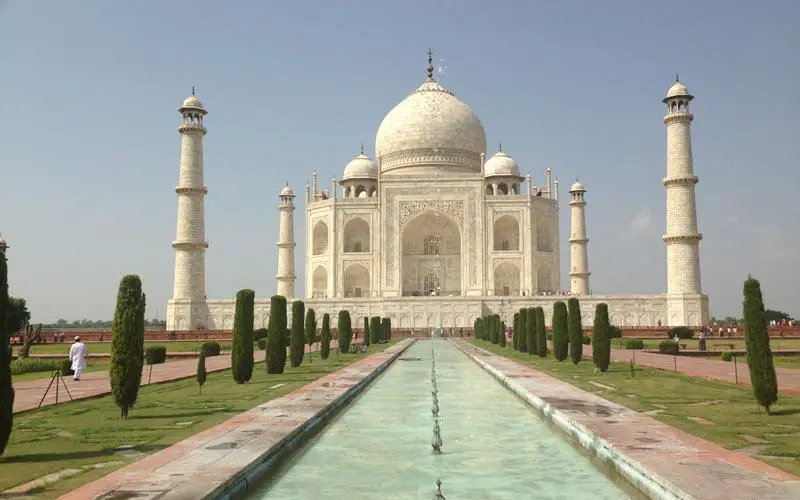
The function of the minarets is both decorative and structural. Decoratively, minarets are intended to emphasize symmetry and add aesthetic balance to the building. Structurally, minarets were used to balance the weight of the building and provide stability. In addition, the minarets have balconies at the top and these balconies were used for the call to prayer.
Garden and Water Channels
The Taj Mahal is surrounded by a large garden. This garden was designed with regular geometric arrangements and symmetry was emphasized. The garden starts from an entrance gate in front of the building and extends between the main building and the water channels.
The water channels are located in the center of the garden. The garden is decorated with various types of plants. Many kinds of flowers, trees and shrubs are used to enhance the beauty of the garden. The canals are placed in perfect symmetry with this garden. The canals are used to emphasize the geometric arrangements and enhance the reflection effect of the water. A large pool in the center of the garden uses the reflection patterns of the building to create a spectacular representation of the building.
Material Use and Colors
The main material used in the construction of the Taj Mahal is white marble. This marble gives the exterior and interiors of the building an elegant look. The white color of the building is considered a symbol of purity and beauty. At the same time, the precious stones and mosaics used in the decorations and details of the building add richness and splendor to it. These include precious and rare stones such as lapis lazuli, rubies, coral and pearls. The history of the Taj Mahal, the purpose of its construction, the architects, the architecture and the use of materials all emphasize the uniqueness and importance of this magnificent structure.
Style and Influences
With its striking design, the Taj Mahal represents an elegant synthesis of Mughal and Islamic architecture. The architectural origins of this majestic structure are shaped by the architectural style of the Timurid Empire, reflecting the distinctive character of the Mughal Empire. At the same time, traces of Persian and Indian architectural traditions are also evident in this monumental monument. These rich influences define the Taj Mahal’s unique position in the history of world architecture.
Decorations and Details
The exquisite details of the Taj Mahal are adorned with carvings and mosaics on white marble. These works of art adorning the structure display the graceful dance of cultural floral motifs, the aesthetic delicacy of calligraphy and the perfect harmony of geometric patterning. The tiny details created within the Taj Mahal add depth and meaning to the structure, mesmerizing its visitors. Each carving and ornamentation is a work of art created by skilled craftsmen, elevating the beauty of the structure.
Every stone that makes up the Taj Mahal is not only part of this magnificent structure, but also an expression of the rich cultural heritage of the Mughal Empire. This unique and timeless language of design and ornamentation gives each point of the magnificent structure a striking meaning and aesthetic identity.
Taj Mahal’s Interiors and Tombs
Taj Mahal basically means not a mosque but a tomb built for Mumtaz Mahal, the wife of the Mughal Emperor Shah Jahan. The tombs of Mumtaz Mahal and Shah Jahan are definitely inside the Taj Mahal and this does not affect the sanctity of the mosque. Now let’s take a closer look at the interiors of the Taj Mahal.
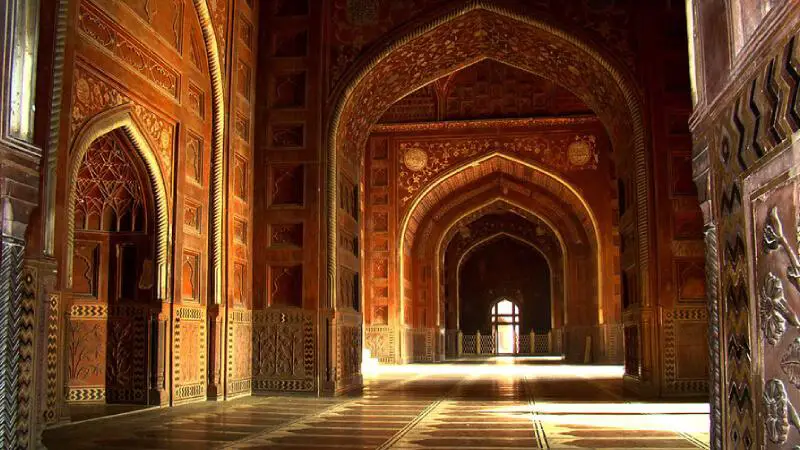
Tomb
In general, the Taj Mahal is divided into two main parts, the outbuildings and the courtyard complex surrounded by the garden. The Taj Mahal is located in the northern part on the main axis of the long world complex and slopes gently towards the Yamuna River. The main elements in the architecture lead towards the main white marble building.
Tomb
The tomb is the main focal point of the complex. This is the large white marble complex mentioned in the section. It is built on a square base and has a symmetrical form with doors under its arches. All four sides of the structure form a 50-meter octagon of cubes with chamfered corners and many chambers, which is not found in equal structures. The most interesting fact about this area is that 8 fake tombs of Mumtaz Mahal and Shah Jahan were found in this area.
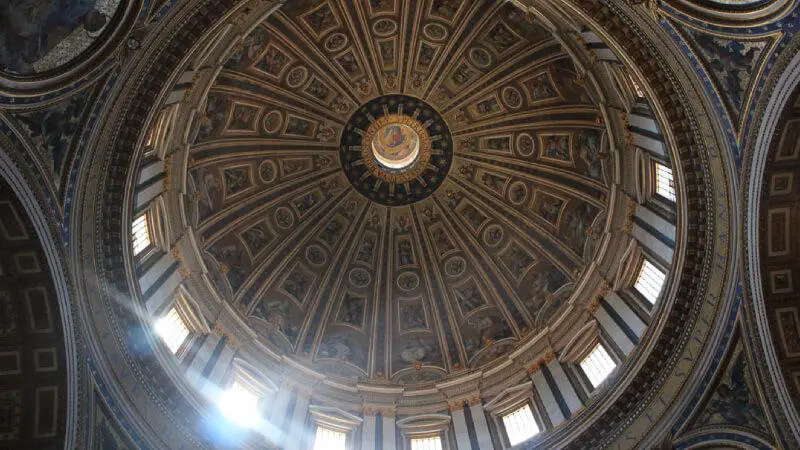
Tomb Room
8 fake tombs are located deeper into the tomb complex, which leads to the real tombs of Mumtaz and Shah Jahan. This burial chamber is located in the basement of the building in the very center of the building. There is a large hall in the interior of the room. It has an architectural design language and decorations worthy of Mümtaz Mahal’s tomb. Since this room was built with the intention of creating an almost soundless crypt, sounds can echo in the room and even the smallest sounds can be heard throughout the room. Although this chamber is not dedicated to real tombs, its design and panache are designed and equipped to resemble a real burial chamber.
Lower Main Burial Chamber
This main burial chamber, which has a southern entrance door leading to the last chamber, the lower chamber, is not accessible to visitors and contains the tomb of Mumtaz Mahal. There are 2 tombs in this room, one of Mumtaz Mahal and the other of Shah Jahan. Shah Jahan’s tomb is located under Mumtaz Mahal. This room was minimally decorated compared to the first area and burial chamber where the fake tombs were found. The walls are decorated with flowers, poppies and plants.
Tombs and Cemeteries
The decoration and monuments of the tomb are designed to amaze the visitors. In the Lower Main Tomb Chamber and the Tomb Chamber, there are fake mausoleums with similar designs. A similar design language is used throughout the mausoleum in order to convey to the visitors what is inside the Main Tomb Chamber.
Decoration of the Mausoleum
There are inscriptions and calligraphy from the Quran on and around the mausoleum of Mumtaz Mahal. There are funnel-shaped calyxes and buds. With the use of small flowers and bird figures, a symmetrical decoration with a perfect form fiction has been created. The whole purpose of all these constructions is to ensure that the spirit of Mümtaz Mahal is a passenger to Paradise.
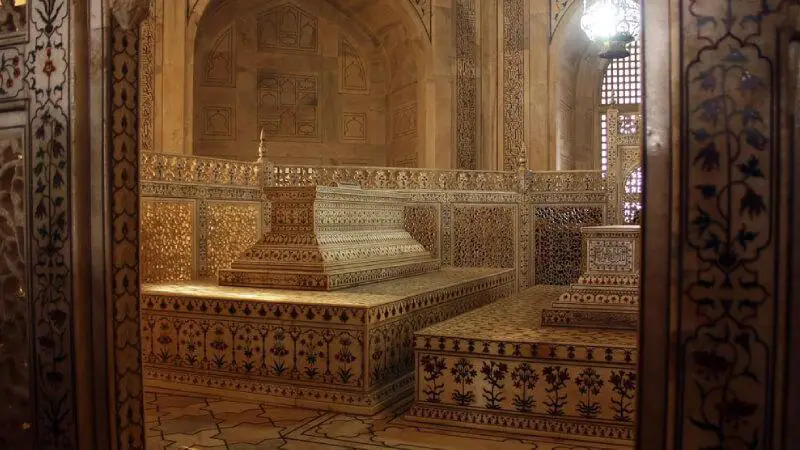
Emperor Shah Jahan’s tomb resembles Mumtaz’s. The only major difference between the mausoleum of the great emperor and that of Mumtaz Mahal is that it is larger and completely covered with flowers. There are no official inscriptions or quotes from the Koran on this monument. The Quranic verse engravings on the outside of the monument, on the other hand, contain verses and wishes for Shah Jahan to rest in peace.
Location and Visitor Experience
Agra City and Yamuna River
The Taj Mahal rises in the heart of the historic and beautiful city of Agra, India, overlooking the magical banks of the Yamuna River. This unique location offers a mystical aura and a spectacular view, providing visitors with an unforgettable experience. As the river flows calmly around the structure, the splendor of the Taj Mahal is doubled by the reflection of the water.
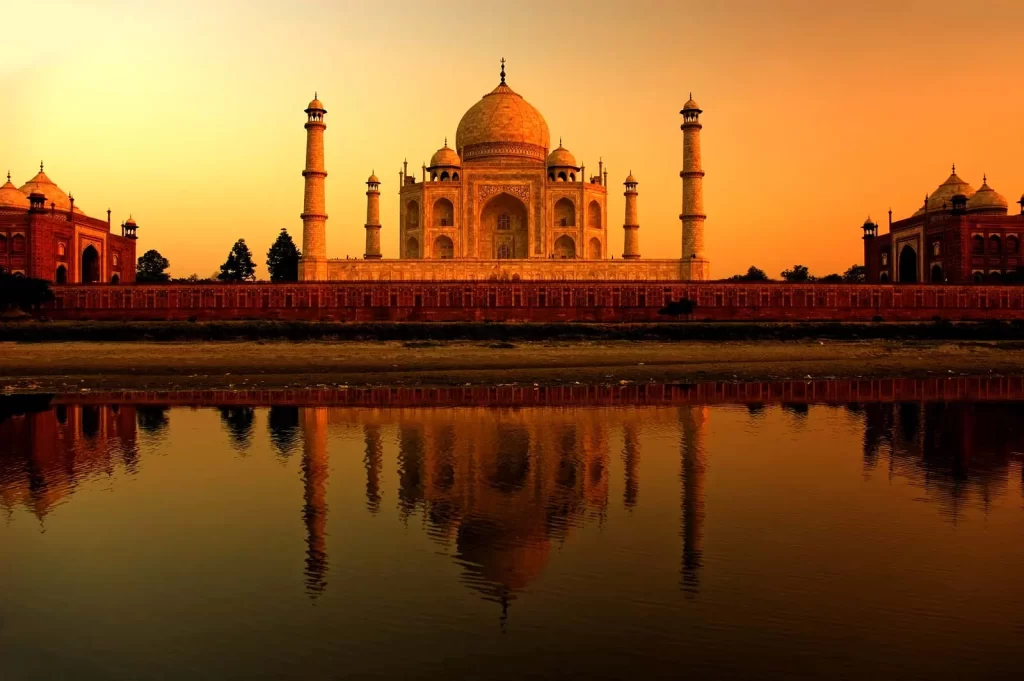
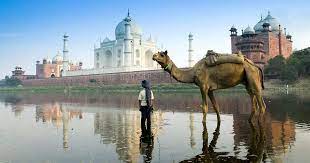


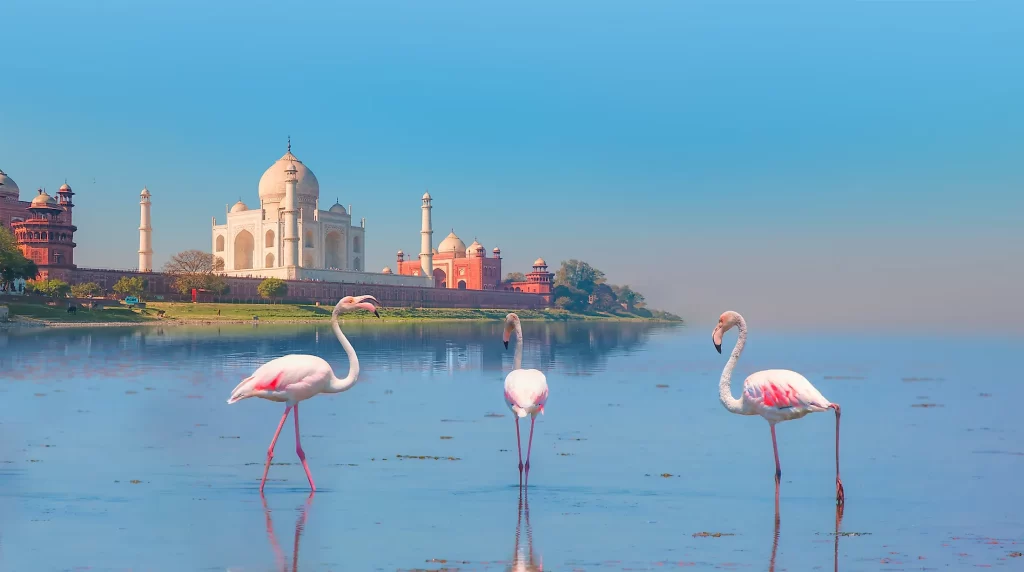
Taj Mahal as a Symbol of Love and Passion
The Taj Mahal is considered a symbol of love and passion. Shah Jahan’s deep love for and devotion to Mumtaz Mahal inspired the construction of this magnificent monument. The Taj Mahal represents the eternity and beauty of love.
The monument is also seen as a story about the greatness of love and what people can do for their loved ones. Shah Jahan expressed his love for Mumtaz Mahal with this magnificent structure and kept her memory alive forever.
Urban Legends and Taj Mahal
- The workers who worked on its construction had their arms cut off and their eyes gouged out. While this legend is a story to marvel at the incredible beauty of the Taj Mahal, in reality it is completely fabricated. The workers who worked on the construction of the Taj Mahal were made to work for their salaries and social security and were released after the construction was completed.
- This legend is based on the fact that the white marble of the Taj Mahal appears in different colors in daylight and shade. However, the Taj Mahal’s color change depends only on daylight.
- That Shah Jahan planned to build a black marble mausoleum for himself on the banks of the Yamuna River, opposite the Taj Mahal, but could not realize this plan because he was deposed by his son. This legend is found in history books written after the death of Shah Jahan. However, the authenticity of this legend is questionable as it was written after Shah Jahan’s death.
Besides these legends, some facts about the Taj Mahal are also curious. For example, approximately 20,000 workers worked on the construction of the Taj Mahal and the construction took 22 years. The marble used in the construction of the Taj Mahal was brought from various parts of India and the cement used in the construction was made from a mixture of egg whites, milk and honey.
Bollywood and the Taj Mahal: The Meeting Point of Cinema and Romance
One of India’s symbolic monuments, the Taj Mahal is not only an architectural marvel, but also a prominent location in Bollywood movies. Before we understand how this magnificent structure provides the perfect backdrop for the romantic and emotional scenes of Indian cinema, let’s take a look at the basics of the Taj Mahal.
The Taj Mahal is located in the city of Agra and was built in the early 17th century. This mesmerizing structure reflects India’s historical significance during the Mogul Empire and is one of the finest examples of architectural marvels. Made of white marble, the Taj Mahal offers a mesmerizing aesthetic with exquisite details, remarkable minarets and perfect symmetry.
Bollywood movies are often famous for their stories of love, romance and emotional bonding. The Taj Mahal plays an important role in these films. It is often at the center of love stories and used as a critical location for romantic scenes. The elegance and dramatic atmosphere of the Taj Mahal creates a deep layer of emotion in these scenes, offering the audience a magical world of romance.
The role of the Taj Mahal in Bollywood films has been used in a variety of ways. Scenes set against the backdrop of this structure create an emotional atmosphere and evoke unforgettable feelings in the audience. In addition, the magnificent architecture and historical significance of the Taj Mahal adds visual appeal to the films and emphasizes the power of love and romance.
In Bollywood history, there are many movies in which the Taj Mahal has been memorable. Here are some of the most iconic Bollywood movies with Taj Mahal:
- “Mughal-E-Azam” (1960): This legendary movie is set during the Mughal Empire and tells a story of love and betrayal. The Taj Mahal is used as an important location for romantic scenes in the movie.
- “Dilwale Dulhania Le Jayenge” (1995): This classic romantic film is one of the most iconic works of Indian cinema. The Taj Mahal appears in the movie as a place where the protagonists share their romantic moments.
- “Veer-Zaara” (2004): This movie tells a love story between India and Pakistan. The Taj Mahal is used as a symbol of love in the movie and stands out as a place where emotional scenes take place.
These films are just a few examples of Bollywood cinema where the Taj Mahal is synonymous with romance and sensuality. The impressive atmosphere and splendor of the Taj Mahal make these movies unforgettable and offer a mesmerizing experience to the audience.
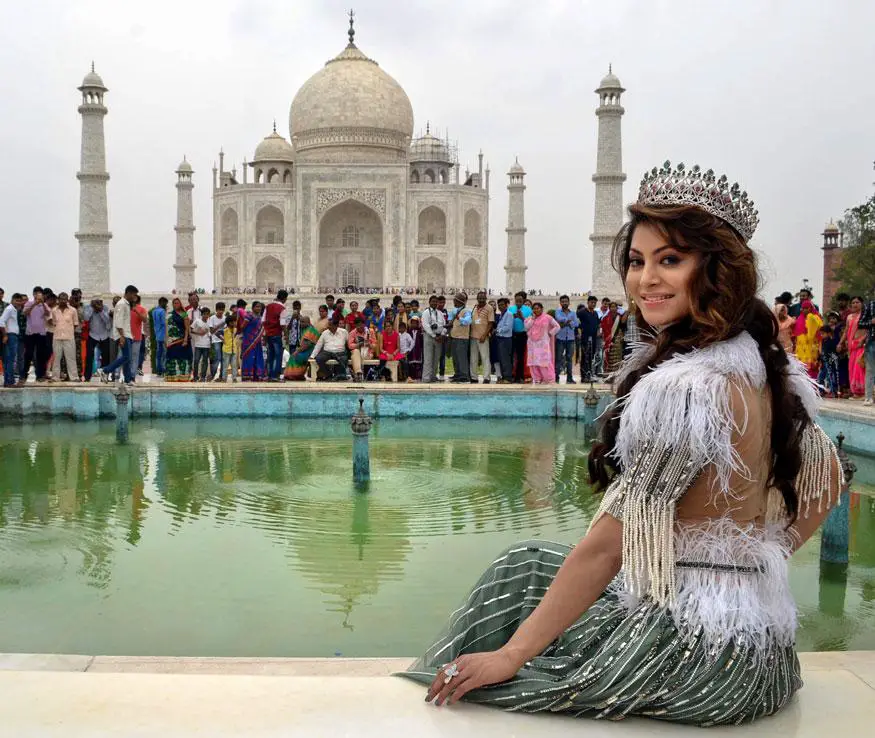
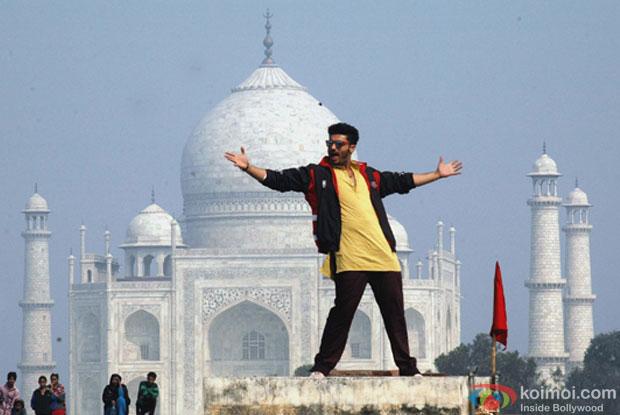
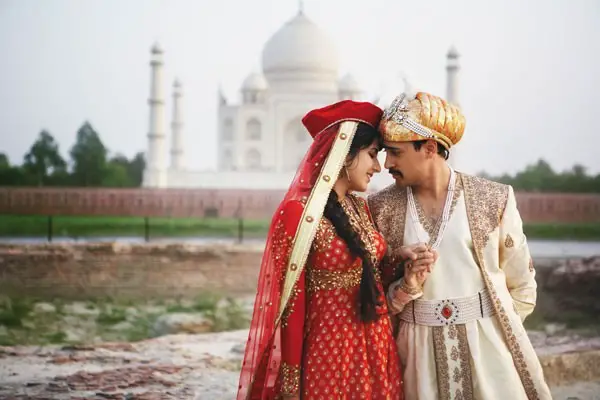
The frequent use of the Taj Mahal in Bollywood films helps both the structure and Bollywood cinema to reach a wide audience. This mutual interaction increases the popularity of Bollywood films and the recognition of the Taj Mahal around the world.
This relationship between the Taj Mahal and Bollywood represents the meeting point of cinema and romance. This iconic structure provides the perfect backdrop for the romantic and emotional scenes of Bollywood movies, offering audiences an unforgettable experience. The Taj Mahal is one of the most mesmerizing structures not only in India but also in the world, and Bollywood’s contribution to this magic is undoubtedly of great importance.
Visitor Experience
The Taj Mahal is one of the most famous monuments in the world, attracting thousands of tourists a year and offering each visitor a unique journey. Visitors can step inside with specially designed tickets to experience this magical structure up close.
As they wander through the main structure, they are transported back in time through walls decorated with fine craftsmanship and detailed carvings. Mumtaz Mahal’s memorial tomb and the adjacent tomb of Shah Jahan are a touching scene of history and love.
The garden offers visitors the opportunity to rest and relax. Strolling through the garden decorated with various flowers, they can feel the tranquility of the greenery surrounding the contrast of the white marble structure of the building. They can also watch the structure from the outside, taking in the mystical view rising from the river.
The Taj Mahal is not only a monument, but also a universal symbol of human creativity and love. As visitors wander around this mesmerizing structure, they have a unique experience of history and beauty and leave with unforgettable memories.
Cultural Significance of the Taj Mahal
Entry to the World Heritage List
The Taj Mahal was inscribed on the World Heritage List by UNESCO in 1983. This prestigious list plays an important role in the protection, promotion and sustainability of the world’s cultural and natural heritage. The inclusion of the Taj Mahal on this list has increased global interest in the structure and emphasized India’s cultural richness.
Influence on Islamic Art
The Taj Mahal is one of the most important and impressive examples of Islamic architecture. Its architecture is full of geometric patterns, calligraphy, mosaics and ornaments. Characteristic of Islamic art, it reflects the aesthetic and architectural heritage of Islamic culture. With its white marble and fine craftsmanship, the Taj Mahal represents the pinnacle of Islamic art.
Place in Indian Culture
The Taj Mahal is a symbolic and cultural landmark of India. At the time of its construction, India was the center of the Great Mogol Empire and this structure reflects the wealth and splendor of the imperial era. The Taj Mahal is also considered a symbol of love and romance in Indian culture. With its story and legends, the Taj Mahal has become an important part of Indian culture.
A Pilgrimage Site for Visitors
The Taj Mahal is a pilgrimage site visited by millions of tourists every year. Visitors come from all over the world to experience the beauty and historical significance of this magnificent structure. The Taj Mahal is a place that leaves a deep impression on the visitors and also serves as a place where people of Hindu, Muslim and other religions visit.
Artistic Details and Decorations
The artistic details and decorations of the Taj Mahal are extraordinary. Built using white marble, this monument is decorated with fine craftsmanship. The exterior walls are decorated with mosaics, calligraphy and geometric patterns. The interior is decorated with precious stones, filigree embroidery and artistic details. This fine craftsmanship and ornamentation adds elegance and a mesmerizing aesthetic to the structure.
The Taj Mahal is world-renowned for its cultural significance, historical and architectural value. With its World Heritage Site, the influence of Islamic art, its place in Indian culture, its place as a place of pilgrimage for visitors and its artistic details, the Taj Mahal is a monument admired by tourists from all over the world. This magnificent structure is an important part of both Indian and world culture.
Preservation Efforts
Preserving the Taj Mahal and passing it on to future generations requires great care and effort. Several measures have been taken to ensure that the unique beauty and historical significance of the structure is preserved. First of all, nearby industrial facilities were relocated to other areas so that air pollution and environmental impacts would not have a negative impact on the building. This measure was taken to ensure that the white marble surface of the building remained clean and undamaged.
In addition, strict measures have been taken to control the flow of visitors and prevent damage to the structure. Measures such as limiting the number of visitors and regulating access to certain areas are aimed at protecting the structure and preventing negative impacts from excessive influx of tourists.
Sustainable Conservation
The Taj Mahal’s conservation efforts are not only planned for today, but also in a sustainable manner for future generations. In addition to cultural and historical values, environmental sustainability is also an important focus. Sustainability measures such as energy-efficient lighting, waste management and environmental impact monitoring aim to protect the environment while preserving the building.
The Taj Mahal is a historical and cultural treasure and an example of the principles of conservation and sustainability. This magnificent monument is a reflection of the measures taken to leave a better world for future generations.
Frequently Asked Questions
- What is the Taj Mahal?
- The Taj Mahal is a fascinating architectural monument in Agra, India, built by the Mughal Emperor Shah Jahan in memory of his wife Mumtaz Mahal.
- When was the Taj Mahal built?
- The construction of the Taj Mahal began in 1632 and was completed in 1653. After nearly 20 years of meticulous construction, this enormous structure emerged.
- Why was the Taj Mahal built?
- The Taj Mahal was built after the sudden death of Mumtaz Mahal, the wife of Mughal Emperor Shah Jahan, to perpetuate her memory and express his love for her forever.
- Where is Taj Mahal located?
- The Taj Mahal is located in Agra, India, on the banks of the Yamuna River.
- What is the Taj Mahal made of?
- The Taj Mahal is made of white marble. A mixture of cement, egg white, milk and honey was also used in its construction.
- Who is the architect of the Taj Mahal?
- The chief architect of the Taj Mahal was Ustad Ahmad Lahauri. Other important architects such as Ustad Isa, Ustad Muhammad Hanif, Ustad Abdul-Karim Ma’mur Khan and Ustad Mukkarimat Khan were also involved in the project.
- What does the Taj Mahal represent?
- The Taj Mahal is considered the purest and most sublime expression of love and devotion. Shah Jahan’s deep love for Mumtaz Mahal and his desire to keep her memory alive forever inspired him to build this structure.
- How high is the Taj Mahal?
- The main dome of the Taj Mahal is approximately 73 meters high. The minarets are approximately 40 meters high.
- What is the entrance fee to the Taj Mahal?
- The adult entrance fee to visit the Taj Mahal is approximately US$20. The fee is lower for local visitors.
- When is it best to visit the Taj Mahal?
- The best times to visit the Taj Mahal are usually early in the morning or late in the evening. There are fewer crowds at these times and you can more easily observe the beauty of the structure.
My Thoughts About Taj Mahal
The Taj Mahal is a structure that represents the pinnacle of architectural perfection. This white marble monument offers an eye-catching simplicity through the brilliance of its roof and the transparency of its interior. The subtleties inside emerge as a product of the depth and thought process of the design. The Taj Mahal maintains a mesmerizing balance, offering a simple and elegant look without exaggeration. Transparency is a unique feature of this structure, creating a seamless link between the outside environment and the interior. Every detail has been carefully considered. The Taj Mahal represents not only aesthetic opulence, but also historical and cultural richness. The Taj Mahal is one of the pioneering examples of romanticism in architecture and proves that its reputation as a world heritage site is well deserved.
What do you think about the Taj Mahal? Do you think this unique structure is one of the greatest masterpieces of world architecture? Does this legendary love story make it special? If you haven’t checked it out yet, you can also read ourBosjes Chapel review here.
Architect: Ustad Ahmad Lahori
Architectural Style: Mughal and Islamic Architecture
Year: 1632-1653
Location: Agra, India
Discover more from Dök Architecture
Subscribe to get the latest posts sent to your email.





